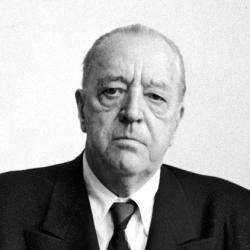
Ludwig Mies van der Rohe
Mies van der Rohe was a German-American architect. He is considered one of the most important architects of modernity. Using the means of technological civilization, Mies wanted to order and represent it architecturally.
Mies van der Rohe was born 27.03.1886 in Aachen, he grew up in simple Catholic circumstances. After elementary school, van der Rohe spent three years at the cathedral school in Aachen. From 1899-1901, he prepared for professional life as a bricklayer's apprentice at the Aachen Trade School. He then got his first job as a draftsman for stucco ornaments.
In 1904 Mies van der Rohe moved to the Aachen architect Albert Schneider. There he was hired as a draftsman for the ornamental facade of the Leonhard Tietz department store. That same year, Mies applied to Bruno Paul, who had just moved to Munich from Berlin. Mies van der Rohe worked with him for the first time on furniture designs and attended his lectures at the Kunsthochschule in Berlin.
In late 1928, Mies van der Rohe began designing the Tugenhadt House in Brno, Czech Republic, which was completed in 1920 and is considered one of the major works of modern architecture. The Tugenhadt House is now a United Nations World Heritage Site.
The interior was designed in collaboration with Lilly Reid. Both for a model apartment in the Weißenhof estate, as well as for the Barcelona Pavilion and the Tugenhadt House. Designed Mies van der Rohe, each a series of furniture. The most famous are the MR series cantilever chairs, the Barcelona armchair, the Brno chair, the Tugenhadt armchair, the Barcelonaliege - day bed and the Barcelona living room table with the distinctive cross frame. The works of Ludwig Mies van der Rohe can still be seen today.
Mies van der Rohe died at the age of 83 years on 17.8.1969 after a serious illness, in the Wessly Memonial Hospital.
1886: Ludwig Mies was born in Aachen. He later adds his mother's maiden name to his and from 1913 calls himself Ludwig Mies van der Rohe.
1897: Mies van der Rohe learns the stonemason's trade from his father at the Aachen Cathedral Building School until 1900.
1903: He is employed as a draftsman by an architectural firm
1905 he works for Bruno Paul in Berlin until 1907
1908 - 1911: Ludwig Mies van der Rohe works in the architectural office of Peter Behrens, at the same time as Le Corbusier, Walter Gropius and Hannes Meyer.
1912: Mies van der Rohe opens his own architectural practice in Berlin.
1922: He joins the "November Group".
1926: Mies van der Rohe is commissioned to design "The Dwelling" for the Werkbund exhibition in Stuttgart. This resulted in the now famous "Weißenhof-Siedlung" in which a residential block was designed by himself.
1929: For the World Exhibition in Barcelona, Ludwig Mies van der Rohe builds the German pavilion for which he also creates the famous furniture designs such as the Barcelona armchair, the stool and the Barcelona table with the X-frame.
In 1930 he builds the Villa Tugendhat in Brno, also called Brno in the Czech Republic. Mies van der Rohe takes over at the Bauhaus in Dessau the leadership that Hannes Meyer had held before him.
1962: He builds the New National Gallery in Berlin. Numerous furniture designs are created, including the famous icons.
1969: On August 17, Ludwig Mies van der Rohe dies in Chicago as one of the most famous architects and designers.

 Deutsch
Deutsch
 English
English